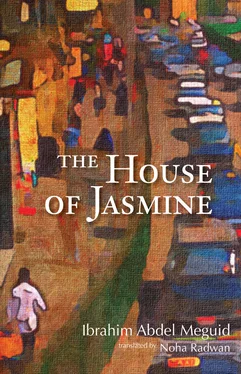I walked on. I sighed deeply as soon as I had walked away from him and thought of returning home without fishing. What did it mean when a scoundrel like that owned a house older than you or me, as ‘Abd al-Salam had said? But I kept on walking.
Nothing should spoil my pleasure with the pure happy breeze around me, or with the wide-open space. Let the house of jasmine be owned by all the thieves in the world. There will never be a person as depressed as the owner of that old house.
The publication of this translation of The House of Jasmine in 2012, not long after the January 25th Revolution that resulted in the ousting of President Mubarak on February 11, 2011, is an opportune and fortunate event. The House of Jasmine , first published in 1984, chronicles the beginning of many of the social and political practices that the 2011 revolutionaries hope to bring to an end.
The House of Jasmine opens in Alexandria on June 13, 1974, the day American President Nixon visited the city, accompanied by his host, Egyptian President Sadat. Nixon had flown to Cairo the day before and with his secretary of state, Henry Kissinger, met with Sadat and other top Egyptian officials. On the following day, the New York Times carried news of the visit: “Arriving in Alexandria yesterday, President Nixon received a rousing welcome from hundreds of thousands as he had yesterday in Cairo.” The Times reporters, perhaps in an attempt to improve the tarnished image of the “Watergate president,” called the visit “triumphant” and interpreted the Egyptian reception as an indication of the people’s trust in Nixon, the harbinger of future peace and prosperity in the region, and of Sadat’s popularity with the Egyptian masses. The novella tells a different story: a story of deception and fraudulence, planned by a scheming administration and carried out by a disenchanted and dejected population. The novella’s protagonist, Shagara Muhammad ‘Ali, is but one representative of that population.
Shagara’s father died in 1967, shortly after the June 5th defeat that marked the end of an era of Nassirist optimism. In the same year, Shagara quit school, began working in the new shipyard, and had to move with his mother to the hills of Dikhayla, where they lived in a poorly constructed house that neither of them liked. When Nixon arrives in Alexandria, seven summers later, President Sadat has succeeded President Nassir, who died in 1970. Egypt has fought another war with Israel, a war that began with an Egyptian military victory and ended with an American-brokered cease-fire, and Shagara is a low-level administrator living a life of utter indifference. He has no ambitions or hopes of his own, and no friends except for the similarly disillusioned trio, Hassanayn, Magid, and ‘Abd al-Salam.
Abdel Meguid’s novella is an indictment of the Sadat era (1970–1981), an era of rampant corruption, when only salesmen and those who have no scruples about making a quick buck can advance, while people who uphold any principles or ideals, Shagara and his friends among them, are bewildered and alienated. Hassanayn seeks refuge in books of history and later in marriage, while both Magid and ‘Abd al-Salam seek a way out through emigration. Shagara becomes a small-time crook in a land of major-league criminals. Ironically, his redemption comes during the course of what went down in official Egyptian history as an “uprising of thieves.”
On January 18, 1977, massive demonstrations erupted in both Cairo and Alexandria. The demonstrations were protesting the increase in the price of bread and other basic food products, including sugar, flour, and cooking oil, that had been announced by Sadat’s government the day before. Upon the advice of the IMF and the World Bank, the price hike was meant to reduce the budget deficit through a reduction of the government subsidies on these products. It was in these demonstrations that Shagara, the aimless loner, finds himself part of a larger and purposeful group:
“Oh!” I say, trying to hide my smile and my inability to understand. I find myself forced to advance toward Sayyid Birsho and the flood of angry workers pouring down Maks Street. Traffic is blocked, and passengers stream out of the tram and stopped cars. The windows of the houses overlooking the street are thrown open, and faces of women and children appear in them. They’re repeating the slogans, and I too am chanting along with Sayyid Birsho.
Shagara gets arrested for his participation in these demonstrations, but he is not convicted, most likely because of the testimony of the shipyard’s chairman of the board of directors, who claims that Shagara only participates in the official rallies that show public support for the president. Shagara’s participation in the demonstrations makes him realize that what legally vindicates him, morally incriminates him:
I had almost shouted out that I was really the one who incited all the demonstrators, that I was the one who pulled up the lamp posts, tore out the sidewalk tiles, burned transportation vehicles, night clubs, and police departments. I don’t lead official rallies, as he said, but only cheat, and I’ve never even gone to any of them.
Shagara refuses to participate in the rallies that were organized for the reception of President Sadat upon his return from Jerusalem in November of the same year. His refusal is, at least partially, inspired by his realization that there is something honorable in the demonstrations opposing President Sadat’s government and something dishonorable in orchestrating rallies in support of it.
The House of Jasmine serves as a counter-narrative to the official history of the Sadat era. Besides telling a different story about Nixon’s reception, it also portrays what Sadat and his state-sponsored media dismissed as an “uprising of thieves” and the minister of the interior claimed was the result of “attempts by hostile forces to spread rumors and incite the masses,” as instead a genuinely popular revolt by the Egyptian working class to defend its basic everyday needs. The January price hikes, which the government announced and then was forced to rescind because of the popular uprisings, were only part of a larger economic policy aimed at liberalizing the Egyptian economy. This policy had its beginnings in 1974, when Egypt received its largest loan from the IMF on the promise that it would privatize Egyptian industries and institutions that had been government-owned and — run under Nassir’s government, to reduce government subsidies and other services, and to give private investment a free rein in directing the Egyptian economy. The result of these liberalization policies was a rapid concentration of wealth in the hands of the few and an increasing income gap. Egypt became a country of net imports and its main export became Egyptian labor, both skilled and unskilled. There is no indication in The House of Jasmine that Shagara understood any of this when he took to the streets with the workers from the shipyard. He probably didn’t. He only had a gut reaction, an intuition that compelled him to be one with the protesting masses.
As part of its function as counter-history, the novel also provides an alternative narrative of how Egyptians received the news of Sadat’s visit to Jerusalem in 1977, and the Camp David agreement of 1979, two moves whose popularity with the Egyptians were “proven” to the West through support rallies not different from those that received President Nixon a few years earlier. In its function as counter-history, The House of Jasmine is not alone. Much of modern Arabic fiction contains more truth than the region’s official state histories, which have been produced during regimes that have traditionally enjoyed almost full control of the media. Particularly notable Egyptian novels that challenge the country’s official historical narratives include Sonallah Ibrahim’s The Committee and Zaat , Radwa Ashour’s Specters , Ibrahim Abdel Meguid’s The Other Place , Idris Ali’s Dongola and Poor , Khairy Shalaby’s The Lodging House , and Alaa al-Aswany’s bestseller The Yacoubian Building, among others. Each of these novels, like The House of Jasmine , represents in its own way an era of corruption, political repression, and a systematic state effort to disseminate misinformation and falsify history.
Читать дальше












